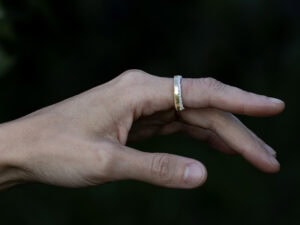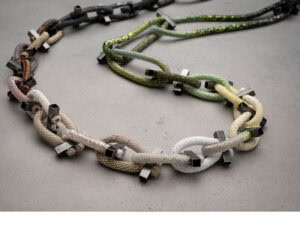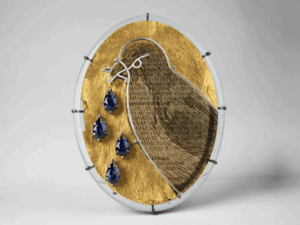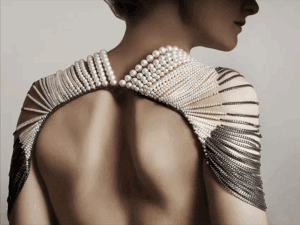Art Jewelry Forum is pleased to introduce this new article series. Each month, it will feature news, events, and opportunities of note in the field, as submitted by the international community of donor that makes everything AJF does possible. Providing a place for our supporters to share what is important to them is one way AJF is celebrating our 20th anniversary year. We believe that our donors, as dedicated jewelry aficionados, have a unique outlook on the world, and we hope you’re interested in the items that they consider noteworthy.
If you are a donor to AJF, you can add news and ideas to the monthly report by going to artjewelryforum.org/news and if you aren’t a donor, but would like to be, go to artjewelryforum.org/donate.
ANNOUNCEMENTS
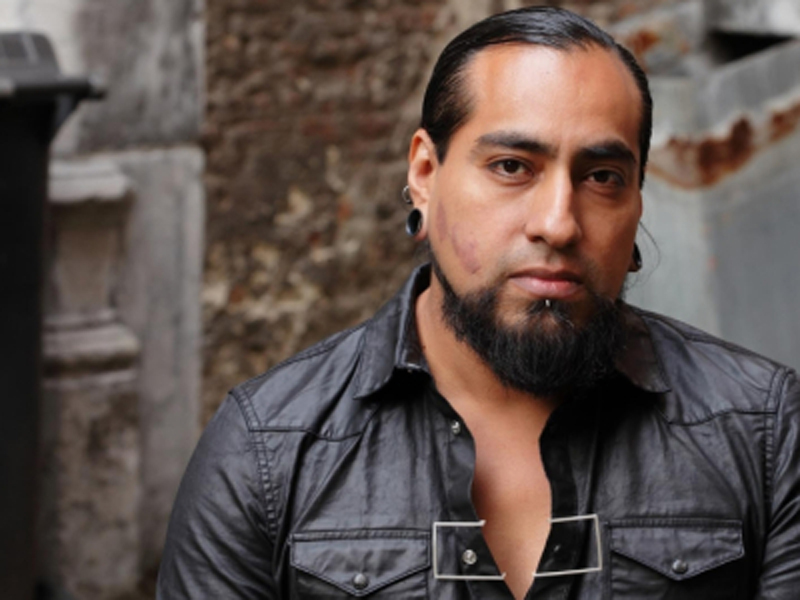 |
Artist, educator, and AJF board member Jorge Manilla has secured the position of head of the metal and jewelry department of the Oslo National Academy of the Arts in Oslo, Norway. |
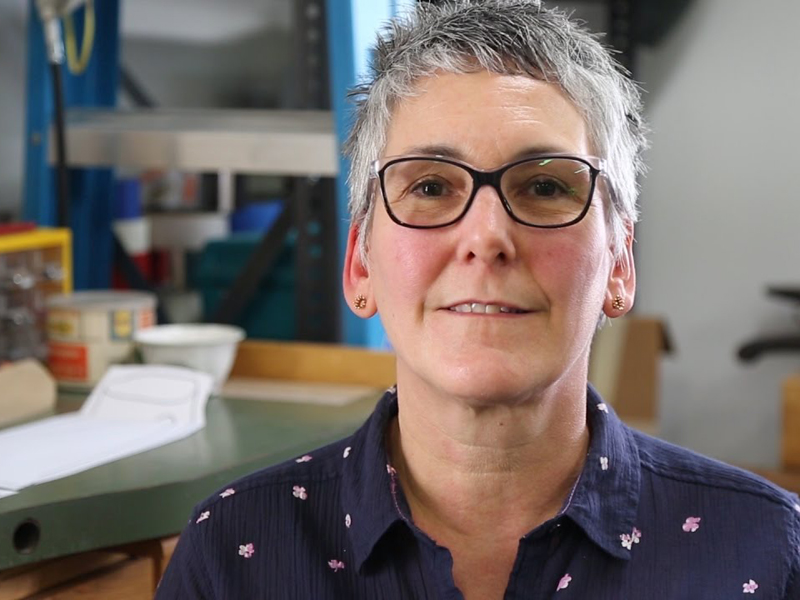 |
Myra Mimlitsch-Gray, artist, professor, and head of the jewelry department at SUNY New Paltz, has been named a 2016 American Craft Fellow. |
MUSEUM HAPPENINGS
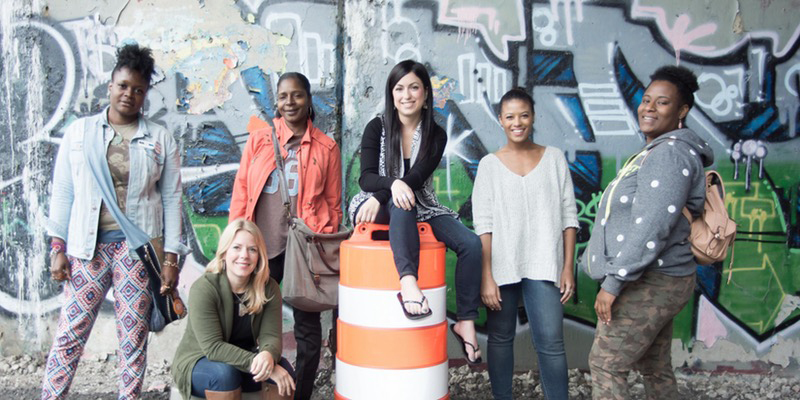 |
The Cooper Hewitt, New York, New York, is holding a series of talks in conjunction with their show By the People: Designing a Better America. The talk on January 26, 2017, at 6:30 p.m. EST is about how a jewelry studio in Detroit is a model for a small business that champions social justice. |
 |
Artist Linda MacNeil’s innovative use of glass to create elegant, wearable jewelry provides a unique opportunity for Museum of Glass to present its first exhibition of jewelry, Linda MacNeil: Jewels of Glass. MacNeil has been a pioneer in both the studio jewelry and studio glass movements since the 1970s. Emerging during that decade with formal training in metalsmithing, MacNeil began fashioning a body of work that combines glass and nonprecious metals—more recently augmenting pieces with precious materials—to make exquisite articles of adornment not rooted in narrative. Over her 40-year career, MacNeil has created more than 700 necklaces, brooches, and earrings. This retrospective exhibition and accompanying catalogue is the first scholarly examination of the development of MacNeil’s work and her contribution to late 20th- and 21st-century American jewelry. On view from January 21–October 1, 2017. |
 |
Galerie Noel Guyomarc’h is pleased to announce the acquisition by the Museum of Arts and Design, New York, of the brooch Monsieur Louis, by the talented emerging artist Aurélie Guillaume. A great article about her work, as well as Zachery Lechtenberg’s, written by the art historian Toni Greenbaum, was published in Metalsmith magazine, Vol.36, N°5, 2016. |
 |
From January 15 until April 9, CODA Museum offers a retrospective of the work of Lucy Sarneel with the exhibition Private Territory in Public. The interplay between the private and public for both the maker and the spectator forms its leitmotiv. Sarneel considers jewelry as the starting point of communication, as a medium that encompasses both the sacred and the profane. Moreover, Private Territory in Public beautifully exhibits sarneel’s jewelry as autonomous art. The exhibition will be opened on January 15 at 14h30 in the auditorium of CODA. Please confirm your attendance by email: aanmeldingen (at) coda-apeldoorn.nl |
EXHIBITION OPPORTUNITIES
 |
Bilk Gallery has decided to broaden its working model to include a different dynamic and open the gallery to artists who may wish to hire the gallery space for a short period to showcase their pieces. We are now seeking proposals/expressions of interest for a limited number of exhibitions in 2017 and 2018. These could be solo exhibitions, installations, experimental works, or group exhibitions—specific to jewelry and objects in metal or glass. We are looking for people whose work follows a distinct individual expression, distinguishable in their one-off and production pieces. We will continue to represent our existing stable of artists and exhibit their work. Proposals will be accepted up until February 28 each year, and open to both Australian and international artists. If you are interested, please go to our website. |
RESIDENCY OPPORTUNITIES
 |
Spend seven days off the grid with Nomadic Artist Casey Sheppard in Southern California at Joshua Tree National Park. The purpose of this residency is to allow artists the opportunity to explore limitations as creative outlets, to learn how to use less, to connect with nature, and to become exposed to the minimalist lifestyle. |
| The International Jewelry Artist Residency at the 92nd Street Y is a juried residency for cutting-edge emerging and established jewelry artists to develop their work in the multifaceted New York City art scene. For a month, from mid-August to mid-September, the residency will provide the opportunity for an international artist with a studio-based practice to develop a new body of work or complete research while engaging with New York’s cultural community. |
READING MATERIAL
 |
LiveForm by Jenni Sorkin—This book is not about jewelry, but is a great look at the significance of women in craft. Is a similar book in order for the contemporary jewelry community?
“Live Form shines new light on the relation of ceramics to the artistic avant-garde by looking at the central role of women in the field: potters who popularized ceramics as they worked with or taught male counterparts like John Cage, Peter Voulkos, and Ken Price. [T]hese women pioneered a hands-on teaching style and led educational and therapeutic activities for war veterans, students, the elderly, and many others. Far from being an isolated field, ceramics offered a sense of community and social engagement, which, Sorkin argues, crucially set the stage for later participatory forms of art and feminist collectivism. |
 |
JEWELS of Whitireia is a survey of the work of Whitireia, New Zealand, jewelry students studying between 2011 and 2016. Featuring the work practices of 25 artists and writings from Justine Olson (curator and collection manager of TePapa—The Museum of New Zealand Te Papa Tongarewa), Courtney Johnson (director of the Dowse Art Museum, Wellington), Vivien Atkinson (artist and mentor), Peter Deckers (coordinator/senior lecturer), and Kelly McDonald (lecturer). JEWELS of Whitireia is edited and produced by JEMbooks, the jewelry students, and Peter Deckers. Catalog can be purchased from Peter.Deckers@whitireia.ac.nz for NZ$20 plus postage, or read at the link. |
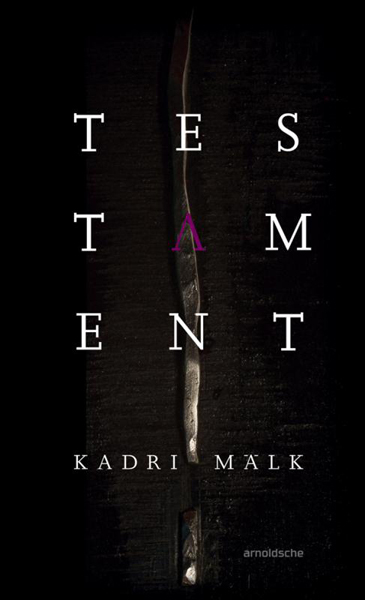 |
Testament, Kadri Mälk’s newest book, has come out from Arnoldsche Art Publishers—sure to be an inspiring read. |
| SPANpoints—With writings from Hilde de Decker, Kim Paton, Tanel Veenre, Peter Deckers, and Sofia Björkman, a gazette from London-based Dialogue Collective and introductions to the practices of the 12 New Zealand HANDSHAKE-3 artists. SPANpoints is edited and produced by JEMbooks and Peter Deckers. Catalog can be purchased from handshakeproject@xtra.co.nz for NZ$20 plus postage, or read at the link. |
IN REMEMBRANCE OF
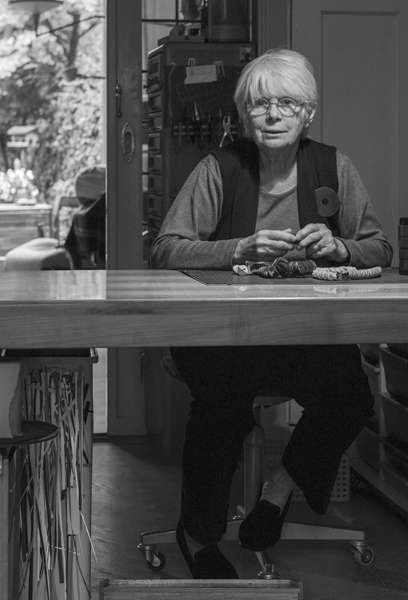 |
Nel Linssen (1935–2016) Dutch jewelry designer Nel Linssen died August 1, 2016, at the age of 80, in Nijmegen, Netherlands. Linssen was a dedicated and innovative artist, and a warm and generous person. She made her jewelry, mainly necklaces and bracelets, from paper, a modest material that in her hands turned out to have unknown and amazing qualities. Her designs were based on folding, rhythm, and structure. She created abstract constructions with an inherent logic, inspired by botanical structures. She was an expert in finding special sorts of paper with the proper resistance, flexibility, and strength, and available in a variety of colors—a process that took time and perseverance.
Starting as a figurative textile artist in the 1970s, Linssen became aware of abstraction and construction when she visited an American quilts exhibition at the Stedelijk Museum in Amsterdam. She started experimenting with paper, stitching parts together and discovering the flexibility of constructions. In 1986 she exhibited her first paper bracelets at Galerie Marzee—they were an instant success. Her first paper jewelry was constructed with elastic bands, but some years later she was able to construct paper jewelry without these rubber bands by creating a connection through overlapping elements. Jewelry pieces from the end of the 1980s and into the 1990s were extremely flexible and could be flipped over into another form, while she also succeeded in reaching the utmost visual spectacle through undulating and zigzag designs. Linssen’s use of the “changeant” effect was legendary. Her most recent jewelry, created in the years 2011–2015 and made from a plastic-covered paper, shows an abundance of color—always applied in subtle tones—and exquisite patterning. Her jewelry is appreciated worldwide, and is part of a multitude of museum collections inside and outside the Netherlands. In 2001 she was awarded the Karel de Grote Prijs (Charlemagne Award), the culture award of the city of Nijmegen. In 2015 Linssen donated about 100 pieces of her jewelry to Museum Het Valkhof in Nijmegen—the city where she lived most of her life. The same museum organized an overview of her work the year before (2014). —Liesbeth den Besten for Art Aurea, January 2017 |
 |
Dieter Zühlsdorff (1947–2016) Samuel Taylor Coleridge stated, “The old definition of beauty … was multitude in unity and there is no doubt that such is the principle of beauty.” This concept was evidenced in the continuous effort made by Dieter Zühlsdorff, the founder of Arnoldsche Art Publishers, to unify scholarship, images, language, and symbols to bring the decorative arts into the broad spectrum of our world through his commitment to publishing.
During the 1980s, Dieter had been working for five years on his Keramikmarken-Lexikon 1885–1935, which grew so compendious that no publisher could be found who was willing to print it. Convinced of the value of his work, he joined forces in 1987 with Gabriela Arnold, his then partner, to found Arnoldsche Art Publishers under her name. He retired from Arnoldsche Art Publishers in 2013 and moved from Stuttgart to a country estate in Oberlenningen, Germany, where he continued with selected projects. (His assistant director, Dirk Allgaier, assumed the position of director and ownership of Arnoldsche in 2015.) Dieter was a man of extraordinary culture—his office and home were hung with great modern paintings and decorated with exquisite parlor suites. Examples of 19th- and early 20th-century European and Russian silver, Art Deco enamel cosmetic cases, and early 20th-century jewelry combined with mid-century German ceramics to create his unique environments. Dieter’s existence was like “The World of Yesterday,” evoking beauty and scholarship—his private life was dedicated to the creation of books. In a January 2016 email, he reminisced how he and my husband, Peter Stern, listened to The Flying Dutchman, by Wagner, as I worked with Dirk; this was the aura created by Dieter, whose passion contributed to the history of our field. —Helen W. Drutt English, December 2016 |
 |
Inge Asenbaum (1925–2016) On October 8, Inge Asenbaum died in Vienna, aged 91. Asenbaum was the founder of Galerie Am Graben (1972–1989), an applied art gallery that eventually turned into an important jewelry gallery in Vienna. Among her artists were radical and distinguished artists such as Peter Skubic, Fritz Maierhofer, Manfred Nisslmüller, and Gert Mosettig. In 1978 she organized the exhibition Schmuck—Tischgerät aus Österreich 1904/08–1973/77 (an exhibition about jewelry, tableware, and cutlery) at the Schmuckmuseum Pforzheim and her own gallery. This exhibition included the conceptual work of Manfred Nisslmüller (with photos, drawings, and text) and Peter Skubic’s Jewellery under the Skin, along with exquisite Wiener Werkstätte jewelry and artifacts from designs by (now) well-known artists such as Josef Hoffmann, Koloman Moser, Adolf Loos, and Georg Klimt.
It is to Asenbaum’s merit that she recognized the artistic importance of the Wiener Werkstätte in a period when nobody was interested in it. She had already started collecting and trading it in the 1950s and 60s when she was running an antique shop together with her husband Herbert Asenbaum. It was also her merit to recognize the spirit and energy of a young generation of jewelry artists, and she started working with them. Besides this, she was interested in Eastern European jewelry artists, and she showed their work and supported them. Asenbaum organized different exhibitions outside of Vienna, such as one on contemporary Austrian jewelry in Ateneo San Basso in Venice, during the Venice Biennial of 1984—the installation was made by the Italian Giampaolo Babetto. In 2000 she was involved in the exhibition Alles Schmuck, organized by the Museum für Gestaltung in Zürich. The exhibition design, by architect Zaha Hadid, contained many pieces of jewelry from Asenbaum’s collection. Her collection includes a broad range of (Central) European contemporary jewelry from the 1960s to the 1990s. In 2014, Deedie Potter Rose, a Dallas-based philanthropist and a fervent collector of art, purchased the Asenbaum collection in Vienna, and she gifted it to the Dallas Museum of Art—a museum she loves and has supported for many years. Rose is herself an enthusiastic collector and wearer of contemporary jewelry. She is passionate about the Asenbaum collection and very interested to have it well researched, documented, and recorded in the museum’s database, a publication, and an exhibition. Therefore, she generously supports a research team of external jewelry experts that will start working in 2017. —Liesbeth den Besten, December 2016 |
MEDIA SIGHTINGS
From The National Jeweler comes the question, “Is Art Jewelry Poised to Take Off?”
The New York Times gives space for novelist Augusten Burroughs to talk about his longtime love affair with jewelry and takes a look at the long career of a jewelry thief.
Vogue magazine is talking about Deedie Rose’s jewelry.


